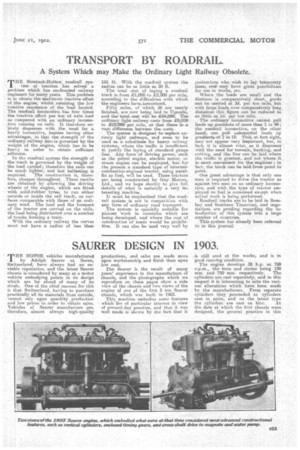TRANSPORT BY ROADRAIL.
Page 11

If you've noticed an error in this article please click here to report it so we can fix it.
A System Which may Make the Ordinary Light Railway Obsolete.
rrHE Stronach-Dutton roadrail aye
tern of traction has solved a problem which has-confronted railway engineers for many years. This problem is to obtain the maximum tractive effeTt of the engine, whilst retaining the low tractive resistance of: the load hauled. The roach-ail locomotive has four times the tractive effort per ton ei axle load as compared with an 'ordinary locomotive running on rails. It therefore sirthinly dispenses with the need for a heavy locomotive, besides having other _advantages, in that the strength of the ordinary railway line is governed by the weight of the engine; which has to be heavy in order te obtain sufficient adhesion.
In the roadrail system the strength of the track is governed by the weight of the load carried; therefore the rails can be much lighter, and JesS ballasting, is
required. The construction Ls, therefore, cheaper throughout. These results are obtained by allowing the driving wheels of the engine, which are fitted with solid-rubber tyres, to run either outside or inside the rail track, on surfaces comparable with those of an ordinary read. The load and the forepart of the tractor are carried on the rails, the load being distributed over a number of trucks forming a train.
With the ordinary railway the curves must not have a radius of lass than
165 ft. With the roadrail system the radius can be as little as 30 ft.
The total cost of laying a roadrail track is. from £1,000 to £2,000 per mile, according to the difficulties with which the engineers have,toicontencl.
Fifty miles, of which 30 are nearly finished, are now being laid in Uganda, and the total coat will he £544100. The ordinary light railway costs front LIAO& to £i11-000 per ,mile, so' that there' lit, a vast difference between the costs.
The system is designed tee misplace entirely light railways, and Mien to 110 used as a substitute for hes.,vg. railway systems, where the traffic is Insufficient to justify the laying of standard gauge line. Any form of driving power, such as the petrol engine, electric motor, or steam engine can be employed,. but for the .present a standard type of internalcombustion-engined trader, using paraffin as fuel, will be used. These tractors are being constructed by Guy Motors, Ltd., and we hope shortly to give full details of what is certainly a very in teresting machine. It must be emphasized that the roadrail system is not in competition with , any form of ordinary road transport.
The system is specially suitable for pioneer work in countries which are being developed, and where the cost. of construction of roads would be prohibitive. It can also be used very well by contractors who wish to lay temporary lines, and' may have great possibilities for use in works, etc.
Where the loads are small and the distance is comparatively short, goods can be carried at 3d. per ton mile, but with large loads over comparatively long distancesthis figure can be reduced to aslittle as Id. per ton mile.
The ordinary locomotive cannot pull, leads up gradients of more than I in 40; the roadrail locomotive, on theother hand., canpull substantial loads up gradients of 1 in 12: This,.at first sight, may not appear very important, but, in fact, it is almost vital, as it dispenses with the need for tunnels, banking, and cutting, and the line can be laid where the traffic is greatest, and not where it is most convenient for the engineer ; in fact, the track can. be laid from point to point.
One great advantage is that only one man is required to drive the tractor as against two men on an ordinary locomotive, and withthe type of tractor employed no fuel is consumed except when actual work is being performed.
Road-rail tracks are to be laid in Bombay and Southern Transvaal, and !segotialions are pending regarding the introduction of this system into a large number of countries.
This system has already been referred to in this journal.






































